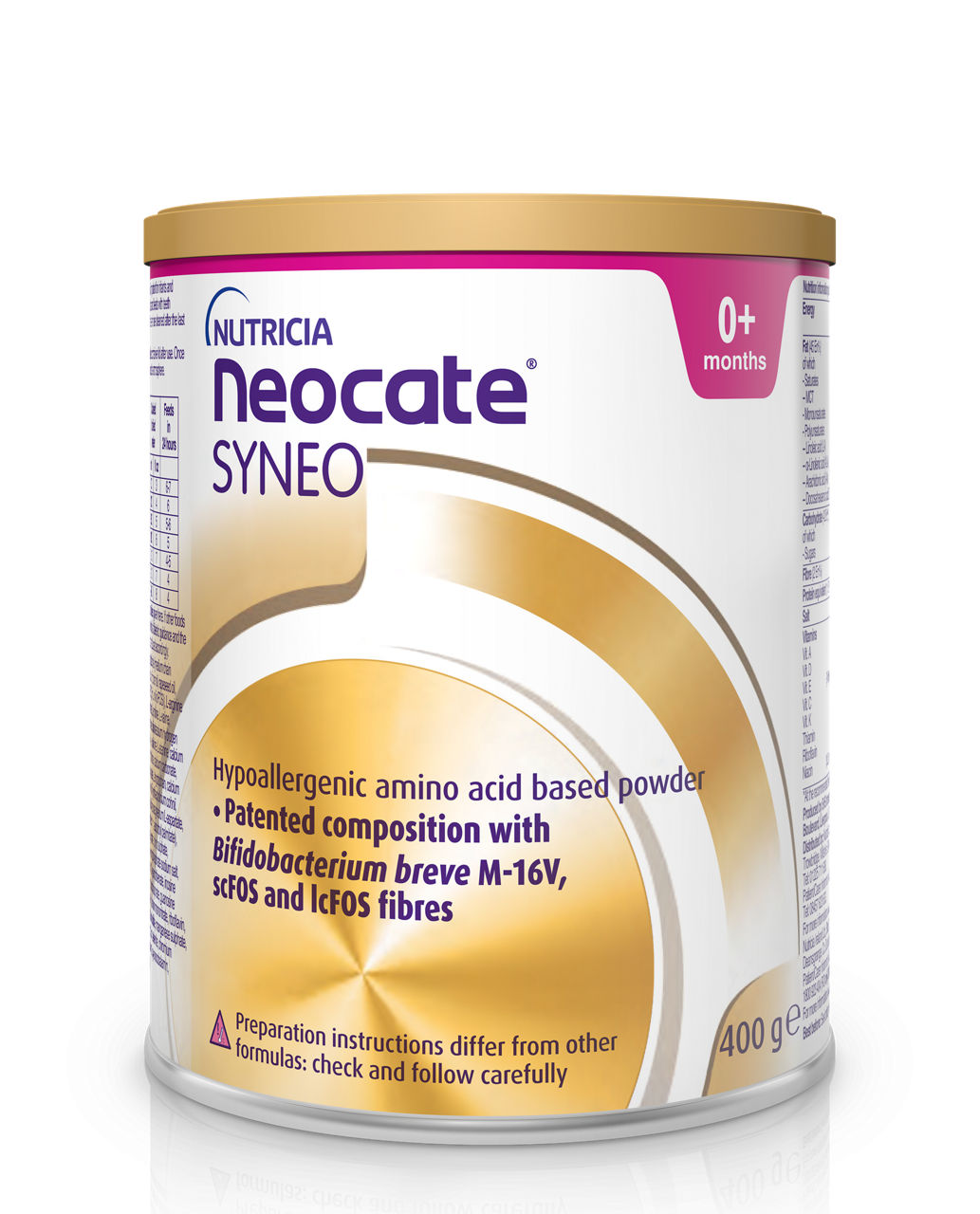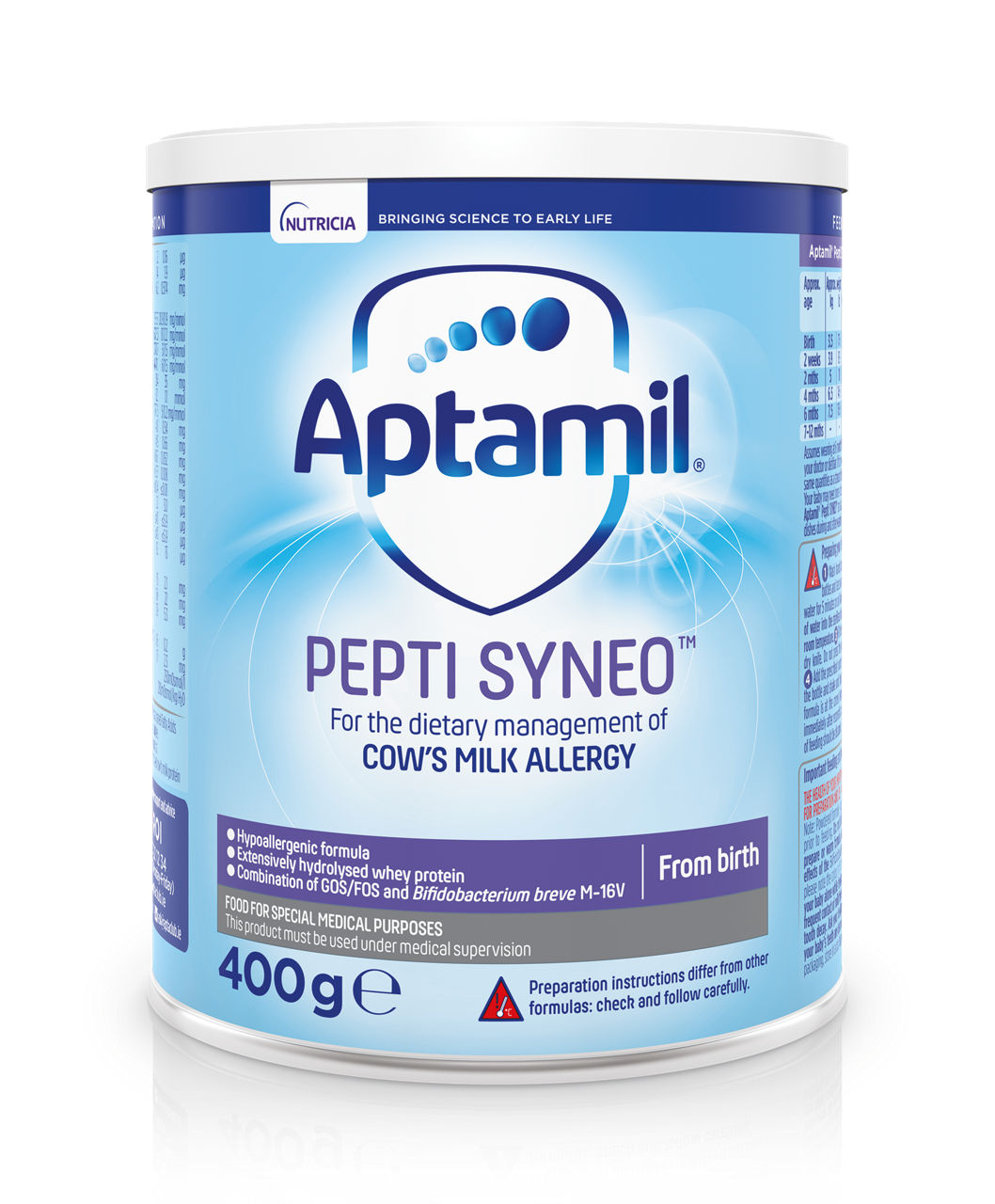Breastfeeding is the recommended feeding method for infants diagnosed with Cow's Milk Allergy (CMA) from birth until two years of age. Breastmilk is a unique source of nutrition for infants. It adapts to meet the infant’s changing requirements and provides prebiotics, probiotics, and non-nutritive factors such as antibodies for the growing infant.
In cases where breastmilk isn’t available, infants with CMA should be prescribed a nutritionally equivalent formula.
Parents of CMA infants should be advised to avoid certain types of formula due to their cow's milk content.
These include:
● standard infant formula (including anti-regurgitation, lactose-free, organic, newborn and their follow-on formulas).
● goat or sheep milk-based infant formula, other mammal milk and formula
● Partially hydrolysed formula
● A2 formula.
Goat and other mammalian infant formulas are not recommended for infants with CMA due to the risk of cross-reactivity with cow's milk proteins1.
Therefore, it's crucial for healthcare professionals to advise parents and caregivers of infants with CMA on the appropriate feeding options and to provide clear guidance on the types of formula to avoid.
What are the suitable alternatives or substitutes to cow's milk for infants with Cow's Milk Allergy?
When a CMA infant cannot be fully breast fed, a hypoallergenic formula is required, of which there are two types available in the UK.
One is known as an extensively hydrolysed formula (EHF). In EHF, cow's milk proteins are broken down into smaller fragments so that the body does not recognise them as an allergen.
The second is an amino acid formula (AAF). Here the formula is made up of individual amino acids and can be used for the treatment of severe CMA.
In most cases an EHF formula should be recommended as the first choice2, 3.
However, if an infant with CMA suffers from severe symptoms such as significant atopic dermatitis, faltering growth or cannot tolerate an EHF, healthcare professionals can prescribe an AAF as an alternative.
For parents who prefer a plant-based formula, soy infant formula can be used as a second choice for the management of CMA but only from six months of age. However, some infants who are allergic to cow's milk protein may also react to soy.
For this reason, parents should always consult with their paediatric dietitian before introducing soy formula to their infant.
It's also crucial for healthcare professionals to provide clear guidance to parents and caregivers of infants with CMA on the appropriate types of formula and to closely monitor infants for any adverse reactions.
Infant formula for Cow’s Milk Allergy
It’s best to advise parents that EHF and AA formulas may have a different taste and smell compared to breastmilk and standard formulas.
However, most infants do not acquire the ability to perceive taste and smell until around 12-14 weeks of age.
If an infant with CMA initially rejects the change to the new formula, healthcare professionals can recommend introducing it gradually into the infant’s current cow’s milk formula feeds over a few days.
It’s also helpful to advise parents that the consistency and colour of the infant’s stools may change (becoming greener for some babies) when switching to EHF or AA formula but reassure them that this is normal.
Tips for transitioning to a hypoallergenic formula
Below is one example of how parents can transition from standard cow's milk formula to an EHF formula, when this is safe to do so.
In severe CMA with anaphylaxis, or when clinically indicated, an immediate switch to the prescribed hypoallergenic formula should be made without delay.
| Day | Total volume in bottle | Formula |
| One | 90 ml | Start with 30ml EHF and add 60 ml cow’s milk formula |
| Two | 90 ml | Increase to 60 ml EHF, reduce to 30ml cow’s milk formula |
| Three | 90 ml | Increase to 90 ml EHF and stop cow’s milk-based formula |
Closely monitor the infant’s response to the new formula and provide ongoing support to parents as needed. By following these recommendations, the transition to an EHF or AA formula can be made smoother.
Other types of hypoallergenic formulas
Partially hydrolysed formula
Parents may ask about using partially hydrolysed formulas (pHF) for infants with CMA. However, these formulas are not recommended for CMA infants as the molecular weight of the peptides in pHF is still too large4 and can cause an allergic reaction in CMA babies.
Therefore, pHF is not suitable for the dietary management of CMA and should not be used as a substitute for breastmilk, EHF, or AA formula.
Formula with added prebiotics, probiotics and synbiotics
Some hypoallergenic formulas may have added prebiotics, probiotics and synbiotics to help support a balanced gut microbiota in food-allergic infants.
These formulas need to be prepared with careful attention to the instructions on the tin.
Hypoallergenic formula with lactose as an ingredient
It is worth noting that some hypoallergenic infant formulas may contain lactose which is known to enhance the flavour. Lactose is a key primary carbohydrate present in breastmilk and has been shown to have a prebiotic effect, help shape the infant microbiota6-8 and facilitate calcium absorption 9.
EHFs containing purified lactose have also been found to be safe and effective in the treatment of CMA10-11.
It is, therefore, recommended to work with a paediatric dietitian to help determine the most appropriate formula for infants with CMA and receive expert advice and support.
Infant formula for infants with Cow's Milk Allergy from 1+ years of age
Breastfeeding is recommended as the optimal source of nutrition for infants from birth until two years of age and beyond. If mothers are unable to breastfeed, healthcare professionals should prescribe a suitable hypoallergenic formula until their infant is two years old.
After the age of two, a calcium and iodine-fortified plant-based milk alternative can be introduced, provided the child has a varied diet and is growing well.
For infants with poor growth or feeding difficulties, transitioning to a plant-based milk alternative may not be appropriate. Many of the available oat and coconut-based plant drinks can be low in fat, protein, and calories for children with higher energy requirements.
Parents should also be warned that rice-based drinks are not suitable for children under the age of 4 ½ years due to the presence of naturally occurring rice drinks5.
In such cases, once the infant is over 12 months of age, they can be transitioned onto the older child’s prescription of the 1+ or Junior range, as these formulas are higher in calories and protein whilst providing a good range of vitamins and minerals to support growth.
A review with a paediatric dietitian is important to ensure that the CMA child is on the most appropriate drink if they have not outgrown their milk allergy.
Weaning advice when formula feeding
For infants diagnosed with CMA, the introduction of milk-free solids typically occurs around six months of age. However, some infants may be ready to start solids earlier or may be advised to introduce high-allergenic foods as early as four months.
For comprehensive guidance on how to support parents with weaning CMA infants, please refer to the article 'Weaning with CMA'
- Maryniak NZ, et al. Alternatives to Cow's Milk-Based Infant Formulas in the Prevention and Management of Cow's Milk Allergy. Foods. 2022;11(7):926
- Venter C, et al. Better recognition, diagnosis and management of non-IgE-mediated cow's milk allergy in infancy: iMAP-an international interpretation of the MAP (Milk Allergy in Primary Care) guideline. Clin Transl Allergy 2017; 7:26. DOI.1186/s13601-017-0162-y
- The GP Infant Feeding Network. Milk Allergy in Primary Care (MAP) Guideline 2019. Healthcare Professional Factsheet. [internet] [cited 2023 March 14] Available from: https://gpifn.files.wordpress.com/2019/10/imap-additional_tool_for_hcps-5rm_-tb_original.pdf
- D'Auria E, et al. Hydrolysed Formulas in the Management of Cow's Milk Allergy: New Insights, Pitfalls and Tips. Nutrients. 2021;13(8):2762. doi: 10.3390/nu13082762. PMID: 34444922; PMCID: PMC8401609.
- FSA. Warning against using rice milk for infants and young children. [internet] [cited 2023 March 14] Available from: https://www.fsai.ie/news_centre/press_releases/rice_milk_warning_10032022.html
- Romero-Velarde E, et al. The Importance of Lactose in the Human Diet: Outcomes of a Mexican Consensus Meeting. Nutrients. 2019;11(11):2737. doi: 10.3390/nu11112737. PMID: 31718111; PMCID: PMC6893676.
- Szilagyi A. Lactose-a potential prebiotic. Aliment. Pharmacol. Ther. 2002;16:1591–1602. doi: 10.1046/j.1365-2036.2002.01321.x.
- Szilagyi A. Redefining lactose as a conditional prebiotic. Can. J. Gastroenterol. 2004;18:163–167. doi: 10.1155/2004/350732.
- Abrams SA, et al. Calcium and zinc absorption from lactose-containing and lactose-free infant formulas. Am. J. Clin. Nutr. 2002;76:442–446. doi: 10.1093/ajcn/76.2.442.
- Niggemann B, et al. Safety and efficacy of a new extensively hydrolyzed formula for infants with cow’s milk protein allergy. Pediatr Allergy Immunol 2008;19:348–54.
- S. Koletzko et al. Diagnostic Approach and Management of Cow’s-Milk Protein Allergy in Infants and Children: ESPGHAN GI Committee Practical Guidelines. JPGN Volume 55, Number 2, August 2012
You may also be interested in
Help us provide information most relevant to you
Please ensure your role and areas of interest are up to date.







